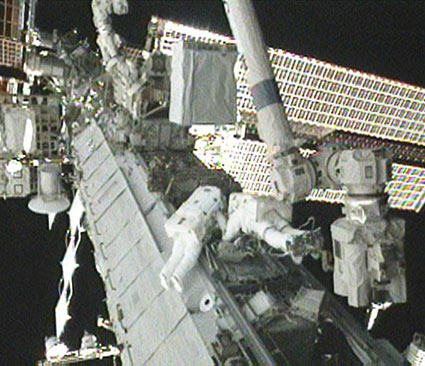NASA Revives Space Station Systems After Tricky Repairs

NASAis steadily reviving systems on the International Space Station following a seriesof complicated spacewalks to repair its vital cooling system.
Flight controllers on Earth are reactivating somesystems for the first time since July 31, when an ammonia coolant pump failureknocked out half of the space station's cooling system. The station's astronautcrew replacedthe faulty pump in three spacewalks, with the most recent one on Monday.
"Essentiallythe coolant loop is operating and flowing ammonia again," NASA spokesmanKyle Herring told SPACE.com. "This morning, they were in the process ofbringing systems back online."
Duringthree spacewalks, NASA astronauts Douglas Wheelock and Tracy Caldwell Dysonremoved the faulty ammonia pump and replaced it with one of four spares storedon the exterior of the InternationalSpace Station. ?
Thecoolantpump failure forced the station astronauts to turn off some experiments andsystems, as well as leave others without backups, in order to prevent theorbiting laboratory from overheating. [Graphic: Space Station's Cooling System ProblemExplained]
Withthe repairs complete, station flight controllers are methodically restartingmany of the systems that were placed offline. These include theelectrically-driven gyroscopes that help maintain the station's attitude, andthe second string of electronics for the space station's robotic arm, Herring said.
"Wewere able to operate all the spacewalks on the single string, so it was not afactor," Herring said. "The robotic arm works just fine on a singlestring, but of course, we always want to have redundancy available."
Breaking space news, the latest updates on rocket launches, skywatching events and more!
Scientificresearch was stalled as well, though mission planners are taking a close lookat what experiments may be salvaged in the weeks ahead.
"Atthat point, the planning team will start to see where they can reschedule allthe activities, like experiment work, that had to be deferred," Herringsaid.
Atthe moment, station managers predict that the space station should be fullyoperational ? as it was before the incident occurred ? by Thursday.
Thespace station is home to six astronauts; three Americans and three Russians. Thestation is slated to keep flying through at least 2020, so spare parts will bea major concern once NASA's space shuttles stop flying next year.
NASAcurrently plans to fly two finalshuttle missions (in November of this year and February 2011) beforeretiring its three-shuttle fleet for good. The possible addition of a thirdshuttle flight is being discussed in Congress.

Denise Chow is a former Space.com staff writer who then worked as assistant managing editor at Live Science before moving to NBC News as a science reporter, where she focuses on general science and climate change. She spent two years with Space.com, writing about rocket launches and covering NASA's final three space shuttle missions, before joining the Live Science team in 2013. A Canadian transplant, Denise has a bachelor's degree from the University of Toronto, and a master's degree in journalism from New York University. At NBC News, Denise covers general science and climate change.
